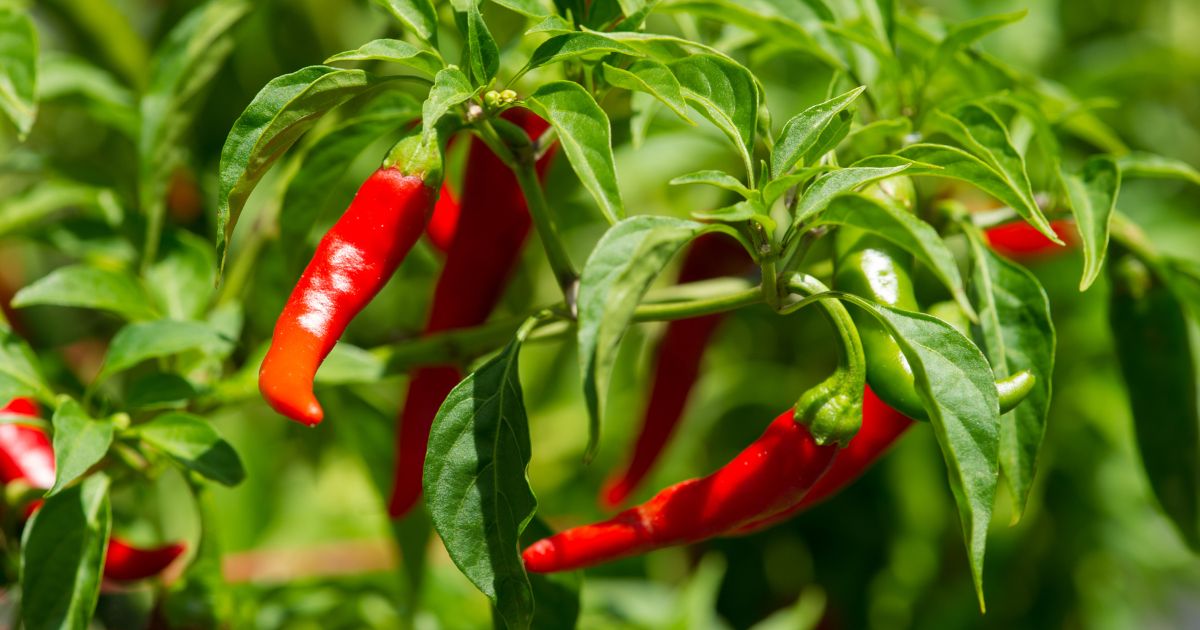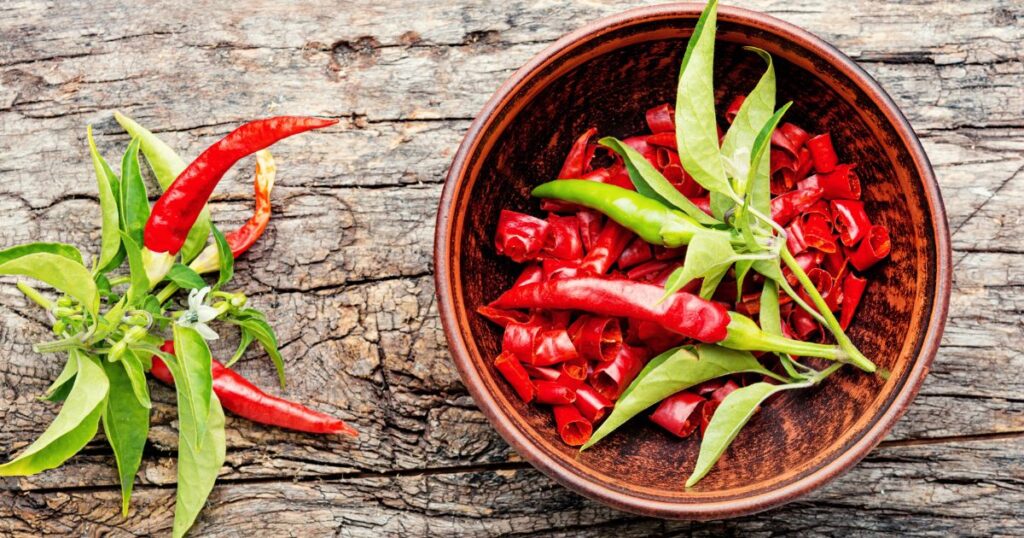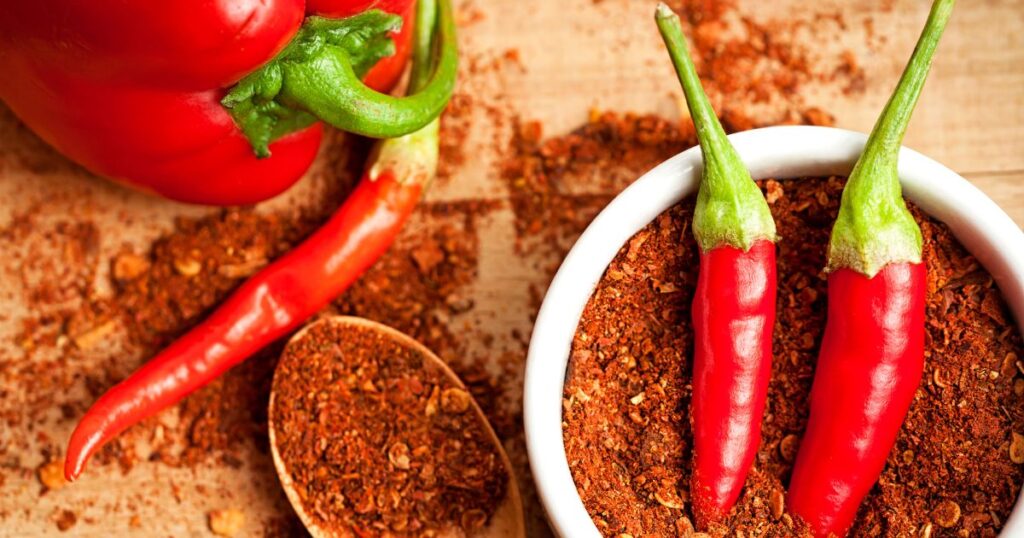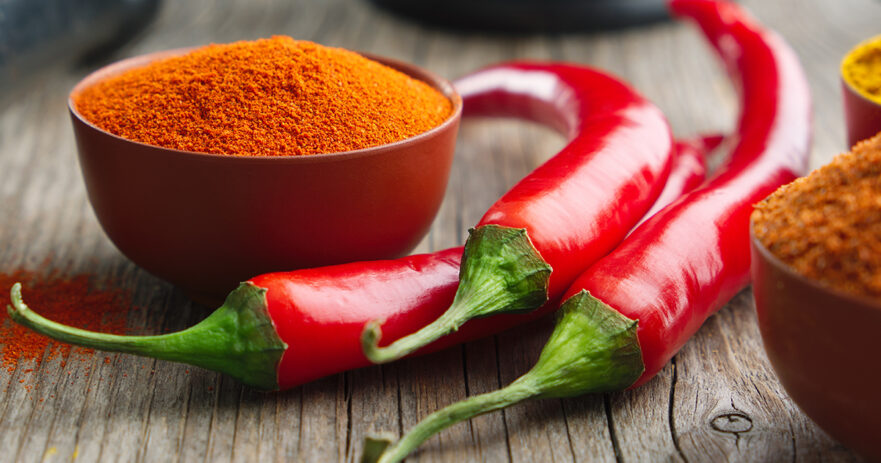In this article about cayenne pepper:
🗺️ Origin and history | 🌶️ Uses | ✨ Appearance and taste | 🌶️ Types | 🧑🌾 Growing – gardening | 👨🍳 Cooking – recipes | 🛒 Where to buy | 🫙 How to store | 👨⚕️ Health benefits | 🌶️ Alternatives and substitutes | ❓ Frequently asked questions
What is cayenne pepper?
Cayenne pepper is a well-known chili pepper recognized for its potent heat and vibrant red color. It gets its name from the Cayenne region of French Guiana, but its influence has spread worldwide. The cayenne pepper’s slender, elongated shape makes it easily identifiable, and people use it in many dishes, ranging from Latin American to Asian cuisines.
People frequently use cayenne pepper in sauces, marinades, and even some desserts. In addition to spicing up dishes, Cayenne pepper adds warmth and depth to the culinary table, whether put on top of a pizza or infused into a rich curry.
| Cayenne pepper | |
| SHU | 30,000 - 50,000 |
| Median SHU | 40,000 |
| Flavor | Tangy, sligthly fruity, moderatly hot |
| Species | Capsicum annuum |
| Origin | French Guiana |
| Uses | Hot sauces, salsas, spice mixes, curry dishes |
Are cayenne peppers spicy? How hot are they?
Cayenne pepper scoville: 30,000 to 50,000 SHU
Cayenne peppers are well-known for their intense heat, making them a go-to for those looking for a robust and fiery kick. Their spice intensity outperforms many other common chili varieties, with a Scoville rating of 30,000 to 50,000 units, making them a favorite among spice connoisseurs.
Cayenne peppers are much hotter than banana peppers (0 to 500 SHUs), jalapeño peppers (2,500 to 8,000 SHUs), and Sport peppers (10,001 to 23,000 SHUs). They are, however, milder than the intense heat of habanero (100,000 to 350,000 SHUs) and Bhut Jolokia (Ghost Pepper), which can reach over 1,000,000 SHUs.
The heat of cayenne peppers is affected by their growth conditions and maturity. Older cayenne peppers generally have more heat, whereas younger ones may be slightly milder.
🗺️ ORIGIN AND HISTORY
Where do cayenne peppers come from?
Researchers believe cayenne peppers originated in French Guiana’s Cayenne region in South America. These fiery and slender red peppers have been a staple in indigenous diets for centuries, and their potent health benefits have a deep-rooted significance in traditional medicinal practices.
As trade routes developed and expanded, Cayenne peppers traveled across continents and into various global cuisines. They became popular in Indian curries and Thai dishes, adding a distinct heat and flavor. The United States widely recognizes ground cayenne pepper as a spice that adds a burst of heat to Creole, Cajun, and other American dishes, highlighting its universal appeal and adaptability across diverse culinary landscapes.
🌶️ USES
What are cayenne peppers good for? How to use them?
As previously stated, Cayenne peppers are famous for their spicy punch and have been used in countless dishes worldwide. Cayenne peppers, a popular addition in many cuisines, improve the taste and visual appeal of many dishes. Their deep red color is instantly recognizable, and the robust heat they add to dishes is both challenging and invigorating.
Powdered cayenne pepper is one of the most common ways to use it. Cayenne pepper powder is a staple in many kitchens, adding a spicy kick to everything from curries to stews. You can sprinkle the powder on top of dishes to add zest or mix it into recipes to add heat.
Another common practice is to make oil infused with cayenne peppers. This oil adds a fiery kick to a variety of dishes, making it ideal for drizzling over pasta or using it as a base for dressings. The cayenne pepper’s heat is beautifully captured in the oil, allowing chefs to control the heat level in their creations effectively.
Cayenne pepper flakes are popular for those who like a little texture. You can sprinkle these flakes on pizzas, pasta, and salads to add heat and a slightly crunchy texture. The advantage of flakes is the ability to customize the level of spiciness.
Another popular method is to incorporate cayenne peppers into sauces or marinades. Cayenne peppers add an unmistakable kick to any dish, whether a fiery salsa or a spicy barbecue glaze.
✨ APPEARANCE AND TASTE
What does a cayenne pepper look like?
Cayenne peppers are slim and elongated, measuring approximately 2 to 5 inches long and half an inch in diameter. They have a sleek, tapered design with a pointed tip. The skin of cayenne peppers is smooth and shiny. In contrast, its color changes from a vibrant green when unripe to a fiery red when fully mature. Cayenne peppers, while most commonly recognized in their vibrant red form, can also be found in shades of orange or yellow, depending on the variety.
What do cayenne peppers taste like?
Cayenne peppers are famous for their sharp, intense heat that awakens the senses. Their flavor is more than just spicy; it also has a fruity undertone. The heat is intense, with many people describing it as a quick, upfront burn that gradually fades, leaving a lingering warmth.
A spicy and slightly smoky flavor becomes more pronounced when dried and ground into a powder. Cooking cayenne peppers reduces the heat while intensifying the fruity flavors. Whether fresh, dried, or powdered, Cayenne peppers add an unmistakable zest to dishes, ensuring a flavorful and spicy experience.
🌶️ TYPES
What are the different types of cayenne peppers?
Cayenne peppers, known for their fiery heat and distinct flavor, come in a variety of colors and flavors. This section delves into some of the most common colors: red, green, golden, orange, yellow, and purple.
The most well-known variety is the red cayenne pepper. Its rich, deep red hue provides a robust spiciness complemented by a subtly sweet undertone. Green cayenne peppers mature into this vibrant red color, intensifying heat and flavor. Red cayenne peppers are commonly dried and ground into powder, making them a pantry staple in many kitchens worldwide.
Green cayenne peppers are younger than their more vibrantly colored counterparts. They have a milder heat than the red variety and a fresh, grassy flavor with a hint of sweetness. Green cayenne peppers are frequently used in culinary dishes to add a gentle kick without overpowering the palate.
Golden cayenne peppers have a brilliant golden-yellow color and a flavor that mixes heat and sweetness. They can enliven dishes both visually and flavorfully.
While similar in heat intensity, orange, and yellow cayenne peppers have a brighter color and a more pronounced sweetness than red varieties. Their long and slim shape, combined with their eye-catching colors, makes them both visually appealing and tasty.
Purple cayenne peppers are the exception, with a deep, almost eggplant-like color. Their flavor is a harmonious blend of spicy and sweet, and they add a distinct visual element to dishes, distinguishing them from the standard red or green varieties.
🧑🌾 GROWING – GARDENING

How to grow cayenne peppers?
These peppers grow best in warm, well-draining soil with plenty of sunlight. Cayenne peppers thrive in areas with a long, hot growing season, but you must plant them in full sun. When it comes to container gardening, make sure the pots are large enough for root growth and have adequate drainage. Regularly watering is essential, but so is avoiding waterlogged soil, which can stifle growth and cause root rot.
Fertilization, preferably with a well-balanced organic fertilizer, will help the plants produce a bountiful harvest.
When to pick cayenne peppers?
The best time to harvest cayenne peppers depends on how ripe or hot they are. Cayenne peppers typically mature 70-85 days after planting. They have a milder flavor if picked green, but allowing them to turn a deep red increases their heat and spiciness. Frequent harvesting encourages more fruiting, ensuring a steady supply of these fiery chili peppers.
👨🍳 COOKING – RECIPES
Cooking / Recipe ideas for cayenne pepper
Cayenne peppers, known for their fiery heat and rich flavor, can add a spicy kick to several dishes with just a pinch. One of the most well-known applications of cayenne pepper is in chili recipes, where its spiciness complements other ingredients to produce a warming, spicy dish ideal for the colder months.
Cayenne pepper chicken is a tempting option, combining the heat of the pepper with the tenderness of the chicken, frequently served with garlic, onion, and tomatoes for a filling main course.
Traditional dishes, such as scrambled eggs or roasted vegetables, can be transformed into spicy culinary delights with a dash of cayenne pepper. A sprinkle on top of chocolate desserts, such as brownies or mousse, can add an unexpected but harmonious heat contrasting the sweetness.
Homemade cayenne pepper sauce is a must-try for hot sauce enthusiasts. Combining cayenne peppers, vinegar, garlic, and a pinch of salt, you can make a fiery sauce that goes well with everything from tacos to grilled meats.
Another intriguing application is cayenne pepper tea, frequently used for its potential health benefits and warming effect.

🛒 WHERE TO BUY
Where can I buy cayenne peppers?
Cayenne peppers are well-known for their fiery heat and are widely available in supermarkets. You can find fresh cayenne peppers in the produce section of most grocery stores and supermarkets. These peppers can also be found in international food markets, particularly in stores that cater to Latin or Asian culinary traditions, due to their popularity in various cuisines.
When purchasing fresh cayenne peppers, look for peppers that have a bright color, wrinkle-free skin, and a firm touch. It’s best to avoid peppers that have decay, softness, or blemishes.
Where can I buy cayenne pepper plants?
Garden centers and nurseries are good places to start for those with a green thumb who want to grow their own cayenne pepper plants. Vegetable plants, including spicy pepper varieties, are commonly sold in these establishments. Furthermore, many online retailers sell cayenne pepper plants ready to be transplanted and nurtured in home gardens. Make sure the plants have strong stems and healthy-looking leaves that are free of disease or stress.
Where can I buy cayenne pepper seeds?
Cayenne pepper seeds are available for those who want to start growing these spicy peppers from scratch. You can find seeds in gardening centers and specialty stores. Cayenne pepper seed varieties are also available online, making obtaining them easier than ever. As with all seeds, following the planting guidelines is critical to ensure optimal growth conditions for a thriving cayenne pepper yield.
🫙 HOW TO STORE
How do I store cayenne peppers?
You can store fresh cayenne peppers in the refrigerator for up to ten days to retain their fiery kick and vibrant flavor. Place the peppers in a plastic bag or an airtight container before placing them in the refrigerator’s vegetable drawer to extend their shelf life. This method preserves the peppers’ spiciness and fresh, crunchy texture.
Dried cayenne peppers or cayenne pepper flakes have a much longer shelf life. Keep them in a cool, dark place inside a tightly sealed jar or container to preserve their intense flavor and heat. When stored properly, dried cayenne can last up to a year or more without losing quality.
Cayenne peppers, like other produce, can deteriorate over time. Mold, an unpleasant odor, or a soft, shriveled appearance are all signs that they have spoiled. If any of these symptoms appear, it is best to discard the affected peppers.
Can cayenne peppers be frozen?
Absolutely! Freezing cayenne peppers is an excellent way to keep their fiery flavor. Begin by washing and removing the stems from the peppers. Depending on your preferences, you can leave them whole or slice them. Place them on a tray in a single layer and freeze until solid.
When the cayenne peppers are completely frozen, place them in freezer bags or an airtight container, where you can keep them for up to a year. To use frozen cayenne peppers, simply take them out and use them right away, or let them thaw before incorporating them into your recipes.
❤️🩹 HEALTH BENEFITS
Are cayenne peppers healthy?
Cayenne peppers are well-known for their fiery heat and numerous health benefits. Capsaicin, the compound that gives hot peppers their heat, is abundant in these peppers, and researchers have studied its potential therapeutic properties. When consumed in moderation, Cayenne peppers can provide your diet with various essential vitamins, minerals, and antioxidants.
Due to its capsaicin content, one of the most notable advantages of cayenne peppers is their ability to increase metabolism. This compound is also pain-relieving, especially when applied topically. Peppers are rich in vitamin C, which helps support immune function, promote collagen synthesis, and improve iron absorption. Furthermore, these peppers are high in vitamin A, which is essential for maintaining healthy vision and skin. Cayenne peppers’ antioxidant properties, derived from flavonoids and carotenoids, help to counteract the harmful effects of free radicals.
However, people should eat them in moderation, especially those not used to spicy foods, as excessive consumption can cause digestive discomfort.

🔄 ALTERNATIVES AND SUBSTITUTES
What is a good cayenne pepper alternative?
When fresh cayenne peppers are unavailable or too hot for your dish, there are several alternatives.
Serrano peppers, finely chopped, are a suitable substitute, and removing their seeds and veins can help manage their spiciness.
Similarly, finely chopped jalapeño peppers can mimic the texture of fresh cayenne peppers while providing a milder flavor.
Thai Bird’s Eye chilies, known for their potency, can be used for a spicy kick; adjust the amount to your heat tolerance. When finely chopped, red Fresno peppers provide a milder but still flavorful alternative. Try finely chopping Anaheim peppers if you want something mild and slightly sweet.
Various options offer distinct flavors to enhance your dishes when looking for cayenne pepper powder alternatives.
Paprika fills the role smoothly, bringing a mild, slightly sweet flavor in its regular form, while smoked paprika adds a delightful smokiness. Crushed red pepper flakes have a similar spiciness to cayenne pepper powder, and you can adjust the amount to achieve the desired heat level.
Chipotle powder, made from smoked and dried jalapeños, adds a smoky flavor and a moderate spiciness that you can use instead of cayenne pepper powder. These alternatives offer a range of flavors and spiciness, allowing you to tailor your culinary creations precisely to your preferences.
How do you pronounce cayenne pepper?
Cayenne pepper is pronounced as kai-yen pep-per, emphasizing the “kai” sound at the beginning.
🙋 FREQUENTLY ASKED QUESTIONS
FAQ about cayenne peppers
What is cayenne pepper good for?
Cayenne pepper has numerous applications and notable benefits. It adds depth and intensity to dishes by imparting a fiery flavor to them. Cayenne pepper is known for its potential health benefits in addition to its flavor. It may stimulate metabolism because it is high in capsaicin, its active component. This compound has also been linked to pain relief and digestive support, highlighting cayenne pepper's dual role in flavor enhancement and potential wellness benefits.
Is cayenne pepper good for you?
Absolutely! Cayenne pepper is a flavorful spice that is also high in nutrients. Cayenne pepper, high in vitamins, minerals, and antioxidants, may help digestion and metabolism. Capsaicin, its primary active compound, has been studied for its potential anti-inflammatory and pain-relieving properties, implying cayenne's multifaceted health benefits.
Is cayenne pepper the same as red pepper?
Not exactly. While both are members of the Capsicum family, the cayenne pepper is a chili pepper. The term "red pepper" refers to a variety of red-colored peppers, including cayenne. Cayenne pepper is a type of red pepper, but not all red peppers are cayenne.
Can I eat cayenne pepper before bed?
Cayenne pepper before bed is generally safe; however, its spicy nature may cause temporary digestive discomfort for some. Cayenne's active compound, capsaicin, can increase metabolism, disrupting sleep patterns in sensitive people. If you're unsure, eat spicy foods earlier in the evening to see how they affect your sleep.
Is cayenne pepper good for weight loss?
Cayenne pepper has received attention for its potential role in weight loss. Capsaicin, its primary component, is thought to increase metabolism, potentially leading to increased calorie burning. According to some studies, cayenne may help suppress appetite and thus reduce calorie intake. Incorporating cayenne pepper into a healthy diet may help with weight loss.
Is cayenne pepper the same as paprika?
No, cayenne pepper and paprika are not the same spice. Both are made from dried chili peppers but have different levels of heat and flavor. Cayenne pepper is much hotter and has a more direct heat, whereas paprika can range from sweet to smoky and mild to spicy, depending on the variety. The two are sometimes used interchangeably, but subtle differences distinguish them.
